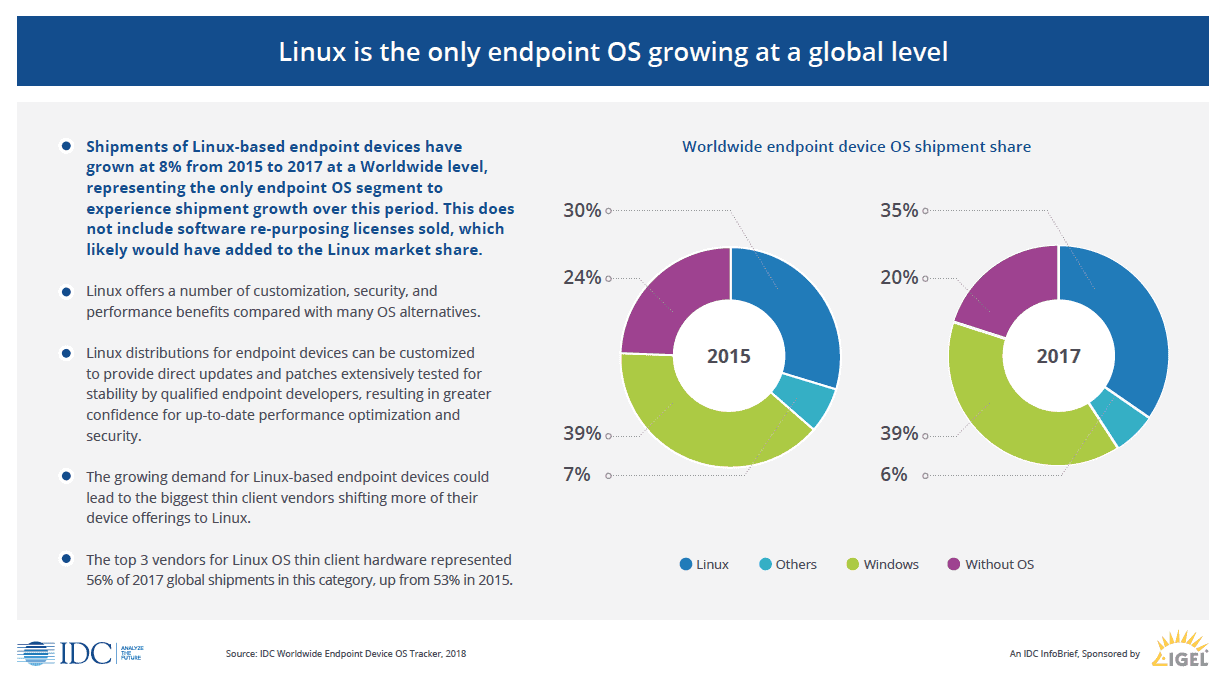IGEL Blog

Cloud Growth is Changing the Endpoint Landscape
You hear it constantly: the cloud is changing everything. Yes, it’s changing file storage and sharing, application development and hosting, data protection and disaster recovery processes and business intelligence for digital transformation. But, endpoint computing too? You bet.
Just to recap some key cloud statistics, IDC estimates that 60% of infrastructure spending will be on public or private cloud by 2022. This contrasts with 46% in 2017. That’s because of the clear advantages offered by a cloud-centric infrastructure, including the ability to lower hardware costs, reduce maintenance requirements, better optimize workloads, and enhance user productivity through the reliable access to cloud-native applications. These benefits are just as valuable at the endpoint as they are in the datacenter.

Changing Endpoint Economics
A recently published IDC InfoBrief, “Linux and the Endpoint security and optimization Market,” states that “global cloud infrastructure expansion is driving growth in underlying endpoint hardware and software that facilitates cloud access in reliable and secure ways.”
So, what’s that mean? Cloud adoption is changing the status quo of end user computing (EUC). Rather than Windows PCs, endpoints and repurposed endpoint devices are the go-to for organizations looking to take advantage of virtual desktop infrastructure (VDI) and desktop-as-a-service (DaaS) workspaces. (IGEL is having considerable success converting older devices to endpoints with our conversion software.) In doing so, enterprises are capitalizing on the value of the cloud, without heavy hardware spend or forklift upgrade procurement costs.
Simplifying Management Complexity
Not only is the cloud dramatically changing the economics of EUC, it’s also making endpoint computing more manageable and secure. That may seem counterintuitive. With users now roaming, working from everywhere using the cloud, it can be difficult for IT to enact comprehensive policy control and remote support. It can be a complex puzzle that has many companies limiting user behavior, and their productivity, to assure compliance and data security.
But, not for users of the IGEL Universal Management Suite (UMS). UMS users have one integrated, low touch system for universal endpoint security and optimization that supports almost any virtual desktop deployment architecture – including the cloud. This means that it’s easier than ever to capitalize on cloud benefits without sacrificing manageability. Something we’re certain will further fuel VDI and DaaS adoption.
The Rise of Linux at the Desktop
Cloud adoption is changing one more thing at the desktop: the operating system of choice. Windows is quickly losing ground. In fact, while Windows remains flat in terms of endpoint OS market share – 39% in 2015 and 2017 – Linux-based endpoint devices have grown 8% between 2015 and 2017 to 35%. That makes Linux the only endpoint OS that’s growing at a global level. And, the cloud has a lot to do with it.
Why? Most major cloud platforms are Linux-based. IDC says that’s “giving the OS a strong base for momentum in cloud environments.” And the Linux trend hasn’t gone unnoticed by major global vendors including Microsoft, Intel and others. You can read more about that in my blog “Why Linux will Rule the World.”
Overcoming the Cloud Security Hurdle
Finally, one more way cloud growth is changing endpoint computing is when it comes to security. A recent report by Gartner said that cloud computing ranks as the top risk concern for executives in risk, audit, finance and compliance. However, leaning on the two technologies outline above, a Linux-based OS and unified endpoint security and optimization, IGEL is enabling IT to overcome the cloud security hurdle. Read my blog “Security: The Key to End User Computing Fulfilling on its Promise.” Here I outline the five ways the IGEL OS enhances the security of EUC – whether on-premises or delivered in the cloud – including the use of embedded protection against viruses and malware through a Linux-based OS that is virtually impossible to manipulate or breach. The security advantages of using a Linux-based OS for the endpoint will continue to propel its use in cloud-enabled infrastructures in combination with enhanced manageability and lower cost.
The cloud will continue to change the landscape of today’s IT – with the endpoint being one of its latest transformations. At IGEL, it’s been something we’ve anticipated for some time. As a result, you can bet that we’ll be at the leading-edge of innovation for cloud-enabled EUC with new features that will make it increasingly more viable, while continuing to lower costs, improve manageability and bulletproof security along the way.


